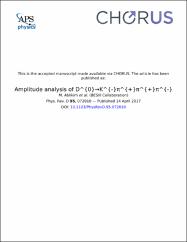| dc.contributor.author | Kolcu, Onur Buğra | en_US |
| dc.contributor.other | BESIII Collaboration | |
| dc.date.accessioned | 2019-07-02T12:36:27Z | |
| dc.date.available | 2019-07-02T12:36:27Z | |
| dc.date.issued | 2017 | en_US |
| dc.identifier.citation | Ablikim, M., Achasov, M. N., Ahmed, S., Ai, X. C., Albayrak, O., Albrecht, M., . . . Collaboration, B. (2017). Amplitude analysis of D-0 -> K- pi(+) pi(+) pi(-). Physical Review D, 95(7), 16. doi:10.1103/PhysRevD.95.072010 | en_US |
| dc.identifier.issn | 2470-0010 | |
| dc.identifier.issn | 2470-0029 | |
| dc.identifier.uri | https://hdl.handle.net/20.500.12294/1542 | |
| dc.identifier.uri | https://dx.doi.org/10.1103/PhysRevD.95.072010 | |
| dc.description | Kolcu, Onur Buğra (Arel Author) | en_US |
| dc.description | Kolcu, Onur Buğra (Arel Author) | en_US |
| dc.description.abstract | We present an amplitude analysis of the decay D-0 -> K- pi(+)pi(+)pi(-) based on a data sample of 2.93 fb(-1) acquired by the BESIII detector at the psi(3770) resonance. With a nearly background free sample of about 16000 events, we investigate the substructure of the decay and determine the relative fractions and the phases among the different intermediate processes. Our amplitude model includes the two-body decays D-0 -> (K) over bar*(0)rho(0), D-0 -> K- a(1)(+) (1260) and D-0 -> K-1(-)(1270)pi(+), the three-body decays D-0 -> K-1(-)*(0)pi(+)pi(-) and D-0 -> K- pi(+)rho(0), as well as the four-body nonresonant decay D-0 -> K- pi(+)pi(+)pi(-). The dominant intermediate process is D-0 -> K(-)a(1)(+)(1260)accounting for a fit fraction of 54.6%. | en_US |
| dc.description.abstract | We present an amplitude analysis of the decay D-0 -> K- pi(+)pi(+)pi(-) based on a data sample of 2.93 fb(-1) acquired by the BESIII detector at the psi(3770) resonance. With a nearly background free sample of about 16000 events, we investigate the substructure of the decay and determine the relative fractions and the phases among the different intermediate processes. Our amplitude model includes the two-body decays D-0 -> (K) over bar*(0)rho(0), D-0 -> K- a(1)(+) (1260) and D-0 -> K-1(-)(1270)pi(+), the three-body decays D-0 -> K-1(-)*(0)pi(+)pi(-) and D-0 -> K- pi(+)rho(0), as well as the four-body nonresonant decay D-0 -> K- pi(+)pi(+)pi(-). The dominant intermediate process is D-0 -> K(-)a(1)(+)(1260)accounting for a fit fraction of 54.6%. | en_US |
| dc.language.iso | eng | en_US |
| dc.publisher | Amer Physical Soc. | en_US |
| dc.relation.ispartof | Physical Review D. | en_US |
| dc.identifier.doi | 10.1103/PhysRevD.95.072010 | en_US |
| dc.identifier.doi | 10.1103/PhysRevD.95.072010 | |
| dc.rights | info:eu-repo/semantics/openAccess | en_US |
| dc.rights | info:eu-repo/semantics/openAccess | en_US |
| dc.title | Amplitude analysis of D-0 -> K- pi(+) pi(+) pi(-) | en_US |
| dc.type | article | en_US |
| dc.department | Mühendislik ve Mimarlık Fakültesi, Elektrik-Elektronik Mühendisliği Bölümü | en_US |
| dc.authorid | https://orcid.org/0000-0002-9177-1286 | en_US |
| dc.identifier.volume | 95 | en_US |
| dc.identifier.issue | 7 | en_US |
| dc.identifier.startpage | 1 | en_US |
| dc.identifier.endpage | 16 | en_US |
| dc.relation.publicationcategory | Makale - Uluslararası Hakemli Dergi - Kurum Öğretim Elemanı | en_US |
| dc.institutionauthor | Kolcu, Onur Buğra | en_US |


















